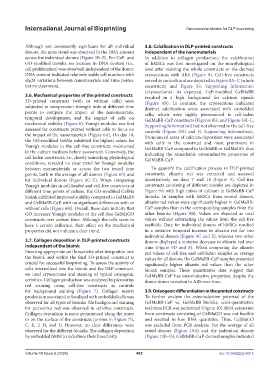Page 490 - IJB-10-6
P. 490
International Journal of Bioprinting Nanomaterial-bioinks for DLP bioprinting
Although not consistently significant for all individual 3.8. Calcification in DLP-printed constructs
donors, the same trend was observed in the DNA amount independent of the nanomaterials
across the individual donors (Figure 5B–E). For CaP- and In addition to collagen production, the calcification
GO-modified bioinks, no increase in DNA content (i.e., of hMSCs was first investigated on the morphological
cell proliferation) was observed, independent of the donor. level after staining the whole constructs or the derived
DNA content indicated relatively stable cell numbers with cryosections with ARS (Figure 8). Cell-free constructs
slight variations between nanomaterials and time points, served as controls and are depicted in Figure 8A–C (whole
but no clear trend. constructs) and Figure S3, Supporting Information
(cryosections). As expected, CaP-modified GelMaBB
3.6. Mechanical properties of the printed constructs resulted in a high background for calcium signals
3D-printed constructs (with or without cells) were (Figure 8B). In contrast, the cryosections indicated
subjected to compression strength tests at different time distinct calcification areas associated with embedded
points to compare the impact of the nanomaterials, cells, which were highly pronounced in cell-laden
temporal development, and the impact of cells on GelMaBB-CaP constructs (Figures 8H; and Figure S3I–L,
mechanical stability (Figure 6). Young’s modulus was first Supporting Information) but not observed in the cell-free
assessed for constructs printed without cells to focus on controls (Figure S3G and H, Supporting Information).
the impact of the nanomaterials (Figure 6A). On day 14, Pronounced areas of calcium deposition were associated
the GO-modified GelMa exhibited the highest values for with cells in the construct and most prominent in
Young’s modulus in the cell-free constructs maintained GelMaBB-CaP compared to GelMaBB or GelMaGO, thus
in the culture medium before assessment. Conversely, the indicating the remarkable osteoinductive properties of
cell-laden constructs, i.e., closely mimicking physiological GelMaBB-CaP.
conditions, revealed no clear trend for Young’s modulus
between nanomaterials or across the two tested time To quantify the calcification process in DLP-printed
points, both in the average of all donors (Figure 6B) and constructs, alizarin red was extracted and assessed
for individual donors (Figure 6C–F). When comparing quantitatively on days 7 and 14 (Figure 9). Cell-free
Young’s modulus in cell-loaded and cell-free constructs at constructs consisting of different bioinks are depicted in
different time points of culture, the GO-modified GelMa Figure 9A with high ratios of calcium in GelMaBB-CaP
bioink exhibited improved stability compared to GelMaBB bioinks. In samples with hMSCs from several donors,
and GelMaBB-CaP, with no significant differences with or alizarin red values were significantly higher in GelMaBB-
without cells (Figure 6H). Overall, these data indicate that CaP samples than in the corresponding samples from the
GO increases Young’s modulus of the cell-free GelMaGO other bioinks (Figure 9B). Values are depicted as total
constructs over culture time. Although the cells seem to values without subtracting the values from the cell-free
have a certain influence, their effect on the mechanical scaffolds. Data for individual donors of hMSCs resulted
properties did not indicate a clear trend. in a tentative temporal increase in alizarin red for two
individual donors (Figure 9C and E), whereas two other
3.7. Collagen deposition in DLP-printed constructs donors displayed a tentative decrease in alizarin red over
independent of the bioink time (Figure 9D and F). When comparing the alizarin
Ensuring appropriate cell bioactivity after integration into red values of cell-free and cell-laden samples as average
the bioink and within the final 3D-printed construct is values for all donors, the GelMaBB-CaP samples presented
crucial for successful bioprinting. To assess the activity of significantly higher alizarin red values than the other
cells internalized into the bioink and the DLP construct, bioink samples. These quantitative data suggest that
we used cryosections and staining of typical osteogenic GelMaBB-CaP has osteoinductive properties, despite the
activities. Collagen production was analyzed by picrosirius donor-donor variation in ARS over time.
red staining using cell-free constructs as controls
for background staining (Figure 7). Collagen matrix 3.9. Osteogenic differentiation in the printed constructs
production associated or localized with embedded cells was To further analyze the osteoinductive potential of the
observed for all types of bioinks. No background staining GelMaBB-CaP vs. GelMaBB bioinks, semi-quantitative
for picrosirius red was observed in cell-free constructs. real-time PCR was performed (Figure 10). RNA extraction
Collagen deposition is more pronounced along the pores from constructs consisting of GelMaGO was not feasible
or on the surface of the constructs (arrows in Figure 7B, and resulted in low RNA quantities. Thus, GelMaGO
C, E, F, H, and I). However, no clear differences were was excluded from PCR analysis. For the average of all
observed for the different bioinks. The collagen deposition tested donors (Figure 10A) and the individual donors
by embedded hMSCs underlines their bioactivity. (Figure 10B–D), GelMaBB-CaP-derived samples indicated
Volume 10 Issue 6 (2024) 482 doi: 10.36922/ijb.4015

